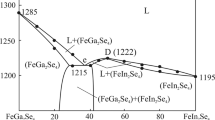Abstract
K4Fe(CN)6·3H2O was studied by a derivatograph in the temperature range +20° to +300° and dielectric constant (ε) measured from −80° to +150°. The loss of the three water molecules occurs at 105° and theε vs T curve shows a Debye relaxation behavior. By using Mason's theory it was possible to classify K4Fe(CN)6·3H2O in the temperature range −25° to +100° C as a para-electric order-disorder crystal.
Résumé
Etude de K4Fe(CN)6·3H2O à l'aide d'un «Derivatograph» entre +20 et +300° mesure de la constante diélectrique (ε) entre −80 et+150°. La perte des trois molécules d'eau a lieu à 105° et la courbeε en fonction deT montre un comportement de relaxation Debye. D'après la théorie de Mason, il est possible de classer K4Fe(CN)6·3H2O comme cristal paraélectrique ordre-désordre entre −25 et +100°.
Zusammenfassung
K4[Fe(CN)6].3 H2O wurde mit dem Derivatograph im Temperaturbereich von+20° bis+300° untersucht und die dielektrische Konstante (ε) im Bereich von −80° und +150° gemessen. Die Abspaltung der drei Wassermoleküle erfolgt bei 105°. Die Kurve vonε als Funktion vonT zeigt ein Relaxationsverhalten nach Debye. Bei Anwendung der Theorie von Mason gelang es K4[Fe(CN)6].3 H2O im Temperaturbereich von −25° bis 100° als para-elektrischen, geordneten-ungeordneten Kristall einzuordnen.
Резюме
С помощью дериватогр афа была изучена соль K4[Fe(CN)6] · 3H2O в области температур от +20° до +300° и для которой была изме рена диэлектрическая кон станта в области температур о т −80° до +150°. Потеря трех м олекул воды происходит при 105°, а кривая в координатахε-T показывает дебаев ское релаксационное пове дение. Представилось возможным, используя теорию Масона, класси фицировать K4[Fe(CN)6] · 3H2O в области температур от −25° до +100° как параэлектрическ ий упорядоченноразори ентированный кристалл.
Similar content being viewed by others
References
I. R.Bonilla, P.da R.Andrade and A.Bristoti, to be published in J. Thermal Anal.
P. Debye, Polar Molecules, Cham. Cat. Co., New York, 1929.
P. da R. Andrade andS. P. S. Porto, Rev. Materials Science, 4 (1974) 287.
W. P. Mason, Phys. Rev., 72 (1947) 854.
D. E. Reilly andT. Tsang, J. Chem. Phys., 47 (1967) 4072.
A. Ya. Krasnikova et al., Soviet Physics, Solid State, 9 (1967) 185.
S. Waku et al., J. Phys. Soc. Japan, 14 (1959) 973.
R. Kiriyama et al., J. Phys. Soc. Japan, 19 (1964) 540.
H. N.Rutt and I. R.Bonilla, to be published in J. Scientific Instruments.
A. Abragam, The Principles of Nuclear Magnetism, chap. X, Oxford University Press, London, 1961.
C. P. Slichter, Principle of Magnetic Resonance Harper and Row Publishers, New York, 1963.
Author information
Authors and Affiliations
Additional information
Work partially supported by Banco Nacional de Desenvolvimento Econômico and Fundação de Amparo à Pesquisa do Estado do Rio Grande do Sul.
P. da R. Andrade deceased on December 16, 1974.
Rights and permissions
About this article
Cite this article
Bristoti, A., Bonilla, I.R. & Andrade, P.d.R. Study of the reaction K4Fe(CN)6·3H2O→K4Fe(CN)6+3H2O by the derivatograph and dielectric constant measurements. Journal of Thermal Analysis 9, 93–99 (1976). https://doi.org/10.1007/BF01909270
Received:
Issue Date:
DOI: https://doi.org/10.1007/BF01909270




